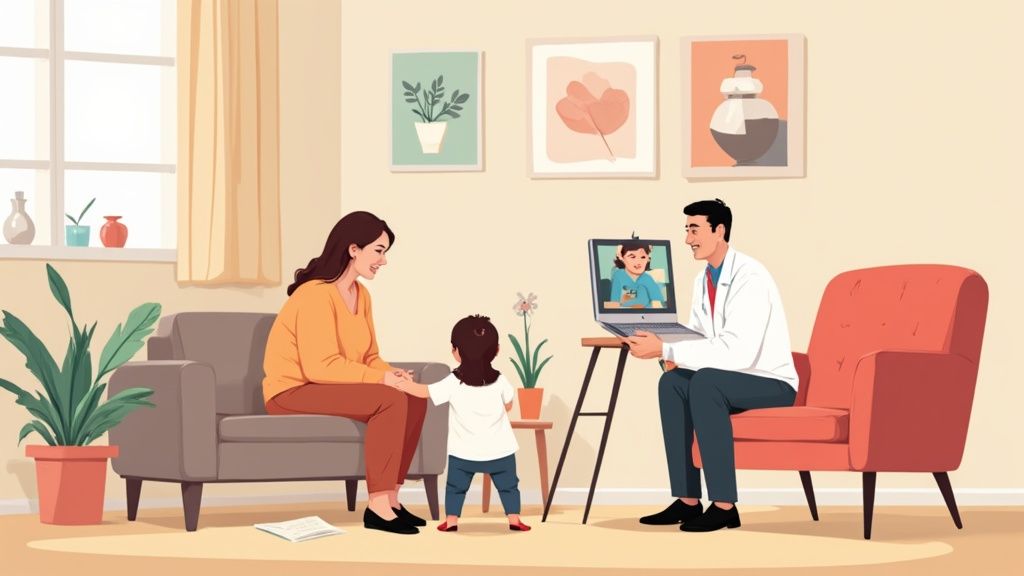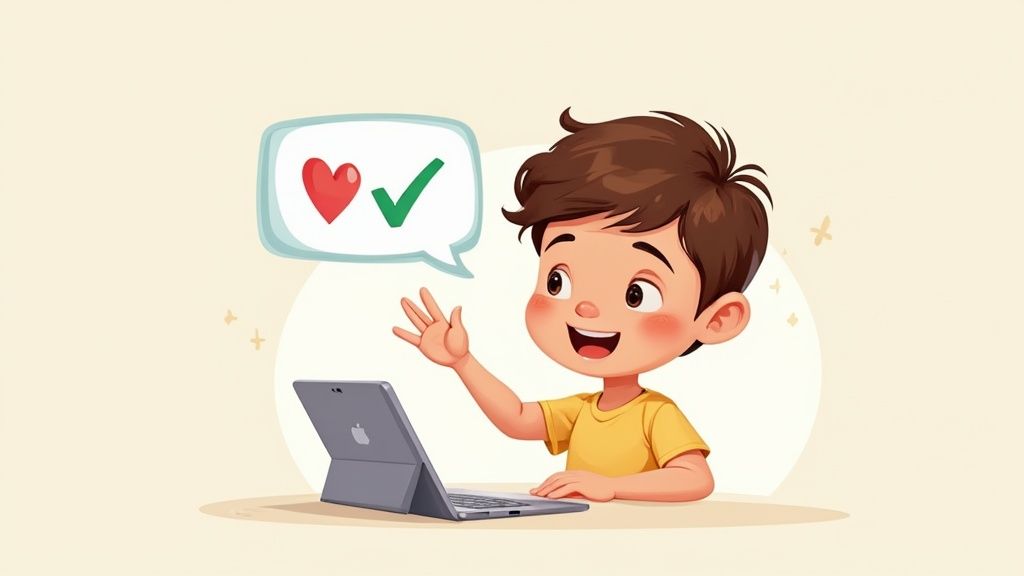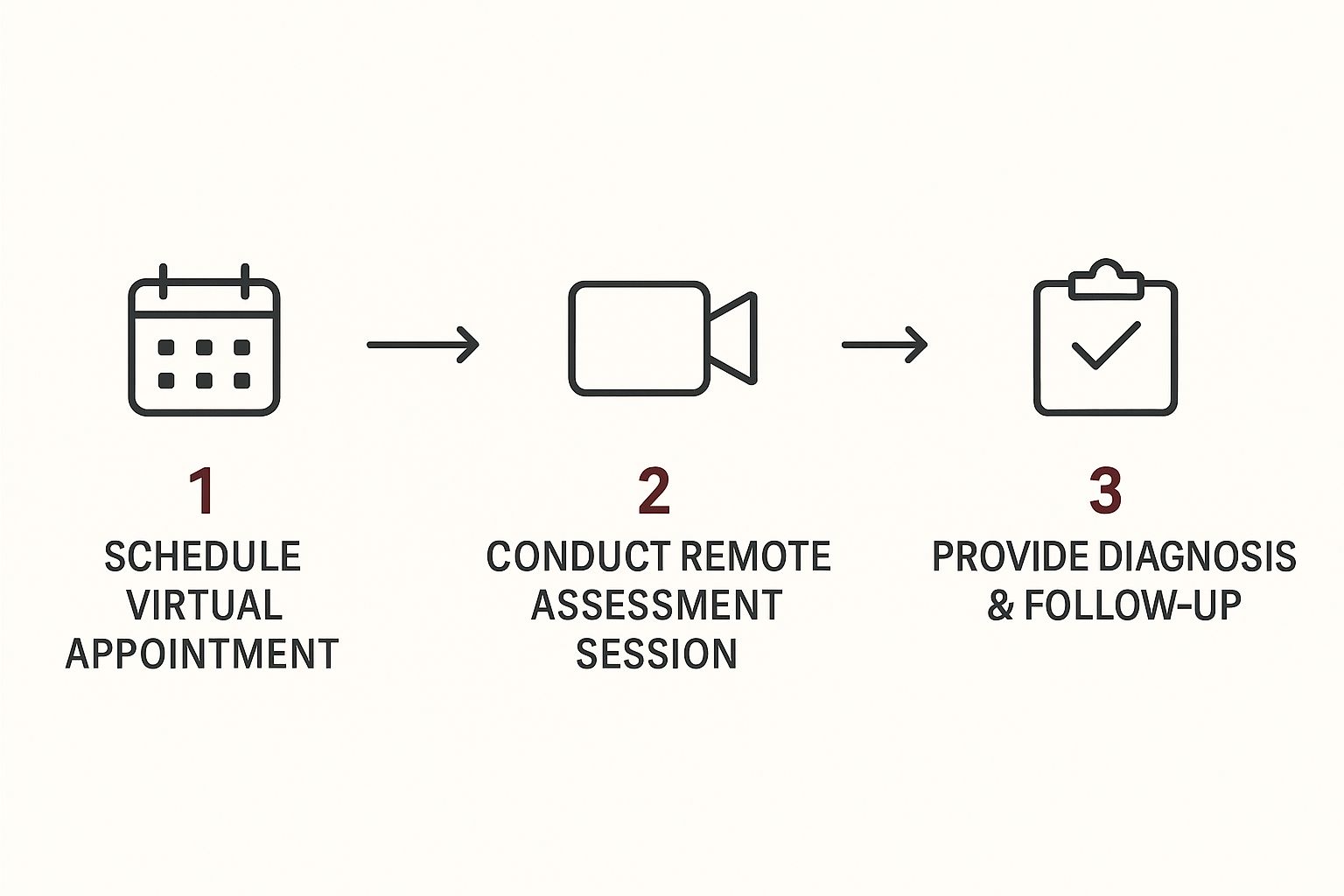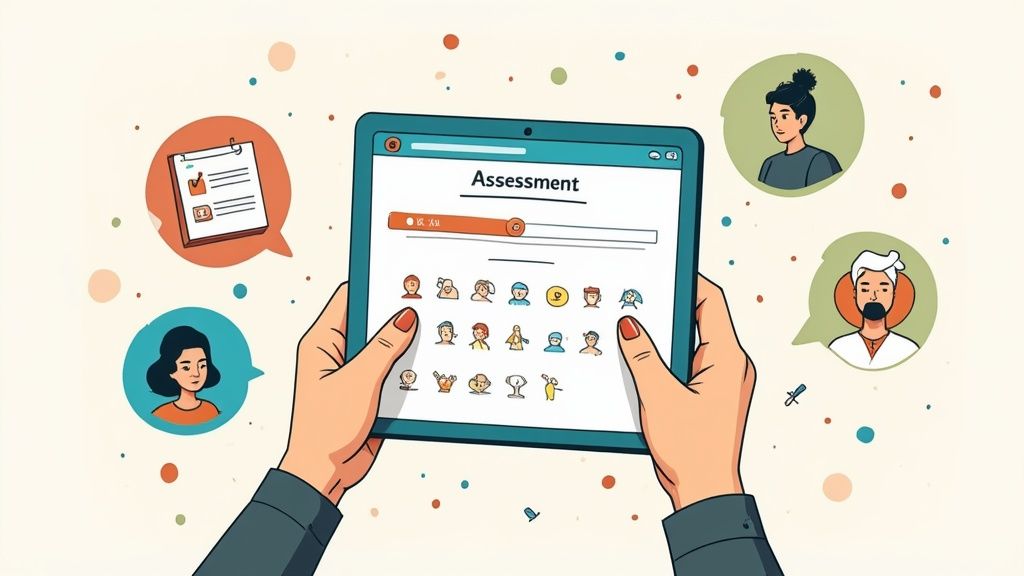Ever wondered what it would be like if the autism assessment clinic could come right to your living room? In a way, it can. That's the essence of a telehealth autism diagnosis: a complete, clinical evaluation for Autism Spectrum Disorder (ASD) conducted remotely using video calls and other digital tools.
Instead of navigating the stress of traveling to an unfamiliar office, the whole process unfolds in a space where your child already feels comfortable and safe—their own home.
How Does a Telehealth Autism Diagnosis Actually Work?

A telehealth autism diagnosis is far more than just a simple video chat. It’s a carefully structured clinical process that’s been thoughtfully adapted for a virtual setting. This modern approach breaks down the usual barriers of travel and intimidating clinic environments, bringing expert care directly to you. It's designed to be every bit as thorough and insightful as a traditional in-person visit.
The evaluation weaves together several methods to build a complete and nuanced picture of a child’s development, behaviors, and interaction styles. The goal isn’t to see less; it’s to see things differently—specifically, to see a child in their most genuine and authentic state.
The Core Components of a Virtual Evaluation
A typical telehealth assessment is a multi-part process. It almost always kicks off with in-depth caregiver interviews. During these conversations, clinicians will ask detailed questions about your child's developmental history, social interactions, and any specific behaviors you've noticed. This dialogue is absolutely crucial for gathering the rich context that a simple observation could never provide.
After the interviews, the focus shifts to direct observation through live video. This is where the real magic happens. A clinician will coach you and your child through a series of specific, play-based activities. These are all designed to gently elicit and observe social communication skills, play patterns, and other key behaviors.
The ultimate goal is to have the child in an environment where they feel safe and secure, and where the diagnostician can view what the family is really experiencing. This allows us to be the most impactful in addressing their needs.
These interactions might feel a bit like a guided playdate, but they are meticulously structured. The clinician may ask you to call your child’s name to observe their response, note their use of eye contact, or see how they engage with their favorite toys. Every seemingly simple activity serves a distinct diagnostic purpose.
Capturing Natural Behaviors in a Natural Setting
One of the biggest advantages of telehealth diagnosis is the ability to observe a child in their own space. This simple shift often eliminates the "white coat anxiety" that many children feel in a sterile, unfamiliar clinic—anxiety that can easily mask their true, typical behaviors. By seeing a child with their own toys, in their own room, with their own family, clinicians get a much more genuine glimpse into their world.
This is particularly powerful for understanding how a child responds to sensory input. For a deeper look at this topic, our guide on understanding sensory sensitivities in adults with autism offers more detail. In a virtual session, a clinician can observe real-world reactions to the sights, sounds, and textures that simply wouldn’t exist in an office setting. This makes the diagnostic picture that much clearer and more accurate.
Ultimately, these elements—parent interviews, guided activities, and naturalistic observation—come together to give specialists the same critical information they would gather in person, leading to a valid and reliable diagnosis from the comfort of home.
Why Remote Diagnosis Is More Important Than Ever
The move toward telehealth autism diagnosis isn’t just about convenience—it's a much-needed evolution in healthcare. As our understanding of autism spectrum disorder (ASD) has grown, so has the demand for timely, accurate evaluations. Frankly, traditional healthcare systems just haven't been able to keep up, creating a major bottleneck.
For so many families, the road to getting a diagnosis is full of frustrating hurdles. It’s not uncommon to face waitlists that stretch on for 12 to 18 months. This isn't just an inconvenience. It's critical time lost during a child's most important developmental years, when early intervention can make the biggest difference.
Bridging the Geographical Divide
On top of the long waits, where you live can be a massive barrier. Families in rural or underserved areas might be hundreds of miles from the nearest qualified specialist. The cost and stress of traveling, taking time off work, and navigating a new city can make getting care feel almost impossible.
This is where telehealth becomes an absolute lifeline. It dissolves those geographical barriers, bringing expert diagnostic services right into a family's home, no matter their address. A family in a small town can now connect with a top-tier psychologist in a major city without ever leaving their living room.
By observing a child in their natural environment, we eliminate the "white coat anxiety" that can mask their true behaviors. This allows clinicians to see what the family experiences daily, leading to a more genuine and accurate assessment.
This approach truly levels the playing field. It helps ensure that a child's access to a quality telehealth autism diagnosis isn't decided by their zip code. It’s a huge step forward in making specialized care accessible to everyone.
Meeting the Growing Demand with Better Tools
The need for accessible diagnostic solutions is clear when you look at the numbers. The global autism diagnostic market was valued at around USD 3.44 billion in 2025 and is expected to hit USD 5.03 billion by 2032. This isn't just because of rising awareness; it's also because of better assessment tools that make a telehealth autism diagnosis more precise than ever. You can dive deeper into these market trends and their impact.
This growth is powered by technology that makes remote evaluations incredibly reliable. Modern virtual assessments are so much more than a simple video call; they are sophisticated sessions guided by well-researched, specific protocols. Clinicians now use a powerful mix of tools:
- Standardized Assessments: Gold-standard tools like the ADOS (Autism Diagnostic Observation Schedule) have been expertly adapted for virtual use.
- Parent-Coached Interactions: The clinician guides parents through specific play-based activities. This turns parents into skilled partners who can help bring out key social and communication behaviors on camera.
- AI-Driven Analysis: New technologies are emerging to help clinicians analyze behavioral markers, like eye-tracking patterns or vocal tones, adding a layer of objective data to their professional judgment.
These tools don't just make the process more efficient—they often make it more insightful. By removing the stress of a strange clinic, a telehealth autism diagnosis offers a clearer picture of a child’s true abilities and challenges, all in the place where they feel most comfortable. This isn't a temporary fix; it's a vital, permanent part of modern pediatric healthcare.
The Step-by-Step Virtual Assessment Process
Getting a telehealth autism diagnosis can feel like stepping into the unknown, but the process itself is actually quite clear and structured. Knowing what to expect can turn that feeling of uncertainty into confidence. The entire evaluation is broken down into a few key stages, each designed to help the clinician build a full picture of your child right in their own comfortable environment.
This whole journey, from scheduling the first call to getting the results and follow-up care, is broken down into three main stages.
As you can see, the path from appointment to diagnosis is designed to be straightforward, making this kind of specialized care much easier for families to access.
Stage 1: The Initial Intake and Caregiver Interview
The journey almost always starts with intake paperwork and a detailed caregiver interview. This isn't just a formality—it’s the foundation for the entire evaluation. During this first video call, you get to tell your family's story.
A licensed psychologist will ask you about your child's developmental history, from their first milestones to their current social skills and communication patterns. They’ll want to hear about your specific concerns and the behaviors you see every day. This conversation is absolutely critical for gathering the context needed for an accurate telehealth autism diagnosis.
Stage 2: The Guided Interactive Observation
Next up is the direct, interactive assessment, which usually happens over a live video call. This isn’t just about watching your child play from afar. The clinician takes on a coaching role, guiding you through specific play-based activities meant to bring out certain social and communication behaviors.
For example, you might be asked to:
- Play specific games: The clinician might suggest a game of peek-a-boo or building with blocks to watch for things like turn-taking and shared fun.
- Call your child’s name: This simple action helps the evaluator see how your child responds to social bids.
- Introduce a new toy: Watching how your child checks out a new object gives the clinician insight into their play style and interests.
It can feel a little odd having someone tell you how to play with your own kid, but it's a completely normal and effective part of the process. Clinicians aren't judging your parenting skills; they are simply creating moments where they can see how your child handles social cues in real-time. This parent-led approach is a cornerstone of a valid virtual assessment.
"I’m going to get a little bossy, and it might feel a little weird because you’ve probably never had another adult tell you how to play with your child, but it’s normal for this process."
The observation part is often surprisingly quick, sometimes lasting only 15-20 minutes. An experienced clinician knows exactly what to look for and can gather what they need efficiently without making it a long, stressful experience for your child.
Stage 3: The Feedback Session and Diagnostic Report
Once the interactive assessment is done, the final step is the feedback session. The psychologist will set up another video call to go over their findings with you. In this meeting, they will explain whether your child meets the diagnostic criteria for Autism Spectrum Disorder (ASD), based on everything they learned from the interview, questionnaires, and observation.
This is your time to ask questions and make sure you understand the results. The clinician will walk you through their conclusions and discuss what the next steps might look like. After the meeting, you’ll receive a formal diagnostic letter or a more detailed report, depending on the service you chose.
This virtual model has become much more common and is backed by solid research. Telehealth became a go-to method for ASD diagnosis during the COVID-19 pandemic, with about 8.7% of children born in 2018 having received a telehealth assessment for autism. Even better, studies show that these virtual evaluations have over 80% agreement with in-person methods, proving they are reliable. You can read more about the accuracy of remote ASD evaluations in recent research. This high level of accuracy makes a telehealth autism diagnosis a trusted way to get the answers and support your family needs.
How to Prepare for a Successful Remote Evaluation
A little bit of prep work can truly make a world of difference for your telehealth appointment. It can turn what feels like a stressful event into a smooth, productive session where the focus stays exactly where it should be: on your child.
Think of it in three key areas: getting your tech right, setting up your space, and preparing for your child’s needs. By tackling these ahead of time, you minimize the chances of technical glitches or distractions, which helps the clinician get a clear, authentic picture of your child’s behaviors and interactions. This is the foundation of an accurate telehealth autism diagnosis.
Get Your Tech Ready
We’ve all been there—the frozen screen, the microphone that won’t unmute. Technical glitches are a common source of anxiety, but thankfully, they’re often preventable. Run through this quick tech check before your appointment to make sure everything connects seamlessly.
- Test Your Device: Whether you’re on a smartphone, tablet, or laptop, open the video conferencing app (like Zoom or Google Meet) a day or two before the evaluation. Do a quick test to see if your camera and microphone are working.
- Check Your Internet: A stable internet connection is non-negotiable. Run a quick speed test online. If you can, try to set up near your Wi-Fi router to get the strongest, most reliable signal.
- Charge Up: The last thing you want is a low-battery warning right in the middle of an important observation. Make sure your device is either fully charged or, even better, plugged in for the entire session.
A quick tip: using a smartphone or tablet is often a great choice. They're mobile, which makes it much easier to follow your child around the room and keep them in the frame as they move and play naturally.
Create a Calm and Quiet Space
The environment you’re in plays a huge role in how the evaluation goes. The goal is to create a space that’s comfortable and familiar for your child but free from extra distractions that could get in the way of the assessment.
By observing a child in their natural environment, we eliminate the "white coat anxiety" that can mask their true behaviors. This allows clinicians to see what the family experiences daily, leading to a more genuine and accurate assessment.
To set the stage, pick a room that is quiet and well-lit. It’s best to turn off the TV, silence your phone notifications, and try to keep background noise from siblings or pets to a minimum. A calm setting helps your child stay engaged with the guided activities and ensures the clinician can hear and see everything clearly.
Prepare for Your Child’s Needs
Finally, having the right items on hand for the interactive part of the assessment will help everything run smoothly. Remember, the clinician wants to see your child’s natural behaviors, so you’re just setting the stage for that to happen.
To help you get organized, we've put together a simple pre-assessment checklist. Running through these items beforehand can help you feel confident and ready when the call starts.
Your Pre-Assessment Checklist
| Category | Task | Why It's Important |
|---|---|---|
| Toys & Activities | Gather a few specific toys requested by the clinician. It's great to have a mix of familiar favorites and maybe one new, interesting item. | This allows the clinician to observe different types of play, from how your child interacts with familiar items to how they explore something new. |
| Snacks & Drinks | Have a simple, non-messy snack and a drink ready to go, but keep them out of sight until needed. | A quick break for a snack can be the perfect reset if a child starts to feel restless, overwhelmed, or just needs a little brain break. |
| A Helper | If possible, it’s incredibly helpful to have another adult present during the call. | One person can focus on engaging with the child, while the other can manage the camera, making sure the clinician always has a clear view of the interaction. |
Having these things ready to go eliminates any last-minute scrambling. It helps you, the clinician, and most importantly, your child have the most effective session possible, paving the way for a clear and helpful telehealth autism diagnosis.
When you're looking for a telehealth autism diagnosis, choosing the right provider is probably one of the biggest decisions you'll make for your family. As more and more clinicians offer virtual services, you need to know how to tell a qualified, credible expert from someone who might not offer the rigorous assessment your child deserves.
Think of it like hiring a specialized guide for an important expedition—you want someone who has the right map, the best tools, and a proven track record of navigating this exact terrain. Your goal is to find a team that not only gets autism but also understands the specific ins and outs of doing an evaluation virtually. This is what ensures the diagnosis is accurate, respected, and actually helps you plan what to do next.
Verify Credentials and Experience
First things first: check the provider's credentials. The evaluation absolutely should be conducted by a licensed clinical psychologist or a developmental pediatrician with specific training and deep experience in diagnosing Autism Spectrum Disorder (ASD). Don't be shy about asking about their qualifications or how long they've been doing these assessments, especially over telehealth.
Look for clinicians who live and breathe neurodevelopmental conditions. A general therapist, while well-intentioned, likely won't have the focused expertise needed for a truly reliable telehealth autism diagnosis. It’s that specialized knowledge that makes all the difference in picking up on subtle signs and forming an accurate clinical picture. For adults exploring this path, getting familiar with the process for an online adult autism diagnosis can also offer some helpful perspective.
Inquire About Their Diagnostic Tools
Any provider worth their salt will be using gold-standard, evidence-based assessment tools that have been properly adapted for remote use. A simple video chat just doesn’t cut it. You should ask them directly: What specific instruments are part of your process?
Reputable providers rely on standardized, well-researched assessments to ensure their virtual diagnosis is just as accurate and reliable as an in-person one. The tools are key because they give structure and validity to the clinician's observations.
They should be able to name the tools they use, like telehealth-adapted versions of the ADOS (Autism Diagnostic Observation Schedule) or other validated interview and observation protocols. If a provider is vague about their methods or suggests they can diagnose from just a brief, unstructured conversation, that's a major red flag.
Evaluate Their Process and Follow-Up Support
A thorough telehealth autism diagnosis isn't a one-and-done appointment. It's a comprehensive process. It should involve:
- A detailed intake process that includes comprehensive developmental history questionnaires.
- An in-depth clinical interview with you (the caregivers) to talk through your concerns and observations.
- A live, interactive observation session where the clinician guides you and your child through specific play-based activities.
- A clear feedback session to walk you through the findings and answer all of your questions.
Just as important is what happens after the diagnosis. Ask what kind of report you'll receive. Will it be a simple letter confirming a diagnosis, or a detailed report packed with personalized recommendations? A quality provider gives you clear guidance on next steps, whether that means therapy recommendations, school support, or connecting you with local resources.
This follow-through is the hallmark of a practice that's genuinely invested in your family's future. With more awareness and telehealth options, recent data shows that roughly 1 in 31 children (3.2%) are now diagnosed with autism, which just goes to show how critical it is to have high-quality, accessible diagnostic services. You can read more about how telehealth is helping to meet this rising demand.
Answering Your Questions About Virtual Diagnosis
Even after understanding the process, it's completely normal to have questions about a telehealth autism diagnosis. Stepping into a virtual evaluation can feel new, and you want to be certain it’s the right path for your family. We've compiled direct answers to some of the most common concerns we hear from parents and caregivers just like you.
Our goal here is to offer the clarity and confidence you need to move forward. Think of this as your quick-reference guide to the accuracy, reliability, and practical side of virtual assessments.
How Accurate Is a Remote Diagnosis?
This is usually the first and biggest question on a parent's mind. The short answer is: very accurate. When a qualified specialist uses standardized, evidence-based tools, a telehealth diagnosis is just as reliable as one done in person.
In fact, research shows that telehealth-specific assessments can achieve up to 92% reliability. These aren't just casual video chats; they are carefully structured evaluations that adapt gold-standard principles for a remote setting. By observing a child in their own home, clinicians often get a more authentic glimpse into their everyday behaviors, free from the anxiety of a new, sterile clinic.
The ultimate goal is to have the child in an environment where they feel safe and secure, and where the diagnostician can view what the family is really experiencing. This allows us to be the most impactful in addressing their needs.
This approach helps eliminate what's sometimes called "white coat anxiety," letting the psychologist see the child’s true interaction and communication styles. The combination of in-depth parent interviews, developmental history, and guided real-time observation creates a complete and valid diagnostic picture.
What Ages Are Best Suited for Telehealth?
Telehealth evaluations are incredibly effective for toddlers and young children, which is great news since early diagnosis is so important. The format works exceptionally well for this age group because it relies heavily on parent-guided play and interaction in a familiar space.
But it’s not just for little ones. Virtual assessments are also used successfully for school-aged kids, teenagers, and even adults. The process is simply adapted to fit the individual's age and communication needs. For very complex cases or if a child truly cannot engage on screen, an in-person visit might be recommended, but that's decided on a case-by-case basis.
It's also important to distinguish between different neurodevelopmental conditions. For instance, understanding the distinction between autism and ADHD can be helpful, and you can learn more in our detailed guide.
What Happens If Technology Fails?
Technical glitches are a valid worry, but they almost never ruin an entire evaluation. Clinicians who specialize in telehealth are pros at handling this. They will have a backup plan ready, like switching to a phone call to finish an interview or rescheduling the live observation part if the internet connection is just too unstable.
A little preparation goes a long way. Testing your connection and charging your device beforehand can prevent most common hiccups. Remember, a brief glitch is just a momentary pause—not a barrier to getting a clear and accurate telehealth autism diagnosis.
How Does Insurance Work for Virtual Evaluations?
The good news is that coverage for telehealth services has expanded significantly. Many insurance plans now cover virtual diagnostic evaluations for autism just as they would for in-person appointments. That said, coverage can vary quite a bit depending on your specific plan and state.
Before you schedule anything, it’s always a smart move to:
- Call your insurance provider directly and ask about their policy on telehealth-based psychological assessments.
- Ask the diagnostic center if they are in-network with your insurance or if they can give you a superbill (which is a detailed, itemized receipt) to submit for out-of-network reimbursement.
Taking these quick steps beforehand ensures there are no financial surprises down the road.
At Sachs Center, our team of expert psychologists specializes in providing accurate, compassionate, and thorough virtual evaluations for Autism and ADHD. We understand the nuances of neurodiversity and are dedicated to providing you with the clarity and support your family deserves, all from the comfort of your home. If you're ready to take the next step, book your evaluation today.


